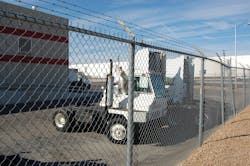There is no firm grasp across the country—and the world—how big cargo theft really is,” said Sam Tucker, CEO of Atlanta-based consulting firm Carrier Risk Solutions.
Tucker said many small trucking fleets he interacts with “have no idea about cargo theft [or] don’t care enough about it because they have not faced cargo theft themselves.”
Erik Dice, an inspector in the criminal investigations division of the Marion County, FL, sheriff’s office, has a similar belief.
“I don’t think that everyone in the industry fully understands cargo theft until they become a victim or know someone who has,” he pointed out.
Cargo theft comes in all shapes and sizes—from a single theft of a loaded trailer at a truck stop to a coordinated strike on a warehouse facility.
Oftentimes, organized crime syndicates are behind these incidents, leveraging the Internet and a global underground market to rapidly move the stolen goods before they can be recovered.
A statement from the FBI outlines the scope of the problem: “Though the precise number of cargo crimes and value of stolen goods is difficult to pinpoint because many incidents go unreported —due to fear of increased insurance rates and reputation-damaging publicity—[we] estimate total loss value is between $15 billion and $30 billion annually.”
Companies such as CargoNet and Sensitech (formerly FreightWatch International) that track cargo theft say the risk is highest on the weekends and gets even higher during extended holiday weekends.
The Federal Bureau of Investigation (FBI) considers
cargo theft a multibillion-dollar problem, yet to the
dismay of experts, far too few recognize the seriousness of the threat—especially in trucking.
“We are being as redundant as we can be when we say this is the most consistent and reliable pattern of any of the continuing analysis,” noted the Supply Chain Information Sharing and Analysis Center, another group that regularly tracks cargo theft.
Incidents are most likely to occur between 3 a.m. and 5 a.m., according to truckload carrier Schneider.
Carrier Risk Solutions’ Tucker said cargo thieves are patient and willing to do their homework. The situation is “fraught with ever-evolving methods” of thieves seeking “vulnerabilities in operations and technology,” he warned.
The FBI highlighted the ability of cargo thieves to strike whenever the right moment arises in a recent blog post regarding the $60 million heist of pharmaceuticals in Connecticut back in March 2010—the largest single theft in the state’s history—during a massive snowstorm.
On a Saturday night in the middle of a blizzard, thieves cut a hole in the roof and disabled the alarm system of an Eli Lilly warehouse, loaded up their tractor-trailer with a variety of drugs, and drove off.
In response, the FBI spearheaded an investigation that eventually led to multiple arrests in Florida and the recovery of millions of dollars worth of stolen goods.
While electronics continue to be among the most desired commodities, they are also often passed over by thieves who expect a higher level of security for that type of “higher-value” cargo.
Food and beverages are examples of items that see a high number of thefts across the country.
A total of 31% of the reported cargo theft incidents in the first quarter of this year fell into that category, according to data from CargoNet, with household items the second most stolen commodity.
Scott Cornell, second vice president with Travelers Insurance, said these are examples of items that are easy to unload and difficult to track.
Inspector Dice, who is with the Florida Sheriff’s office, emphasized that cargo theft trends vary greatly by geographic location and include truck stops, warehouses, ports, and other commercial locations. Localized threats tend to change as particular crime groups move on to other areas.
Also, there are many cargo thefts believed to be particularly underreported, including pharmaceuticals. For example, a recent European-focused report found that the number of such “unreported incidents” is three to five times greater than what is actually reported.
Keith Lewis, vice president of operations for CargoNet, emphasized that today, different groups of thieves specialize in multiple types of physical attacks, while the growing threat of cybercrime means anyone can attempt to facilitate a theft from almost anywhere.
With data showing the majority of thefts occurring in unsecured parking areas, experts recommend greater education and training for truck drivers.
“I believe the major shortfall has been with drivers,” stressed Inspector Dice. “It is not always due to a lack of effort on their part. Some thefts are going to occur even when every protocol is followed. However, if we can remove the low hanging fruit by following the best practices, then the obvious benefit would be a reduction in cargo theft.”
From the perspective of Carrier Risk Solutions’ Tucker, it is fleets with between three and 50 trucks that are most likely will neither have the security resources nor the knowledge to match its business activity. He shares with these fleets a frequently repeated motto: “Cargo at rest is cargo at risk.”
Among the recommendations for drivers is to avoid stopping during the first two-and-a-half hours of a trip, lessoning the risk that thieves will trail the load.
Eliminating stops in unattended areas, using strong padlocks on trailers, locking the doors, and activating a vehicle’s alarm system are among other top security precautions. That underscores Inspector Dice’s frequent message on cutting any type of theft. “Sometimes, simply getting greater compliance in locking car doors in a neighborhood can drastically reduce the incidents of auto burglary,” he stressed.
For fleets, Tucker also urged a $75 investment in air cuff locks, which are “almost impossible to break off” and prevent the truck and trailer brakes from being released.
Reports show a noticeable jump in recent years of what has become known as “strategic cargo theft.” This includes business identity theft (a thief picking up a load by impersonating a legitimate carrier) or fictitious pickups (a thief finds out about a shipment between a trucking company and broker and arrives early with forged paperwork).
Travelers Insurance estimates these methods now represent 10% to 15% of all cargo theft in the U.S. The Internet is aiding criminals, allowing them to monitor load boards and to uncover information about manufacturing centers and distribution hubs.
Multi-use and shared facilities are particularly vulnerable, Tucker warns. With multiple exits and hundreds of people accessing the location at any one time, it is less likely that someone or something out of the ordinary will raise suspicion.
There are several modern techniques thieves are beginning to utilize, leading law enforcement on a technological cat-and-mouse chase.
GPS signal jamming is a new tactic being used by more sophisticated criminal enterprises. While initially unsuccessful, Inspector Dice said thieves have made some inroads in implementing the technology. He added that “one possible solution would be to deploy jamming countermeasures at Dept. of Transportation weigh stations to ‘discover’ the use of these devices.”
Technology itself is also becoming a target. The Supply Chain Information Sharing and Analysis Center is one group warning of an increase in burglaries of electronic control modules from tractors.
CargoNet’s Lewis said regardless of a fleet’s size, there are a variety of steps to reduce the chance of falling victim. It starts with the hiring and vetting process of potential hires, which should include thorough background checks and a detailed training process on how to avoid theft on the road.
Keeping drivers occupied and engaged once on the road can further aid in the fight against cargo theft. Paying them to complete online training modules encourages them to remain with the truck rather than wandering off at a truck stop and yard, he explained.
Fleets should invest in covert GPS devices, which are affordable and provide round-the-clock monitoring. Lewis recommended one in the cab, one in the middle or rear of the trailer, and a third embedded in the actual shipment. Using stainless steel locks instead of plastic seals outside the trailer is a wise investment considering the risks, he notes.
Another key is to ask more questions.
“Rather than just getting a load number, take the time to double-check customer, shipment and destination information with a broker, and be cautious on load boards if the rate seems out of the normal range,” Lewis cautioned.
The writ of law
Cargo theft is, in essence, a form of organized crime and in many cases violates an array of Federal statutes. The California Highway Patrol (CHP) recently compiled a list of applicable Federal laws that directly relate to cargo theft and racketeering activity:
❖ Title 18 U.S. Code, Section 659: Theft from interstate shipments, UPS, Federal Express, Airborne Express, etc.
❖ Title 18 U.S. Code, Section 1951: Interference with commerce by threat or violence.
❖ Title 18 U.S. Code, Section 1952: Interstate and foreign travel or transportation in aid of racketeering.
❖ Title 18 U.S. Code, Section 1957: Engaging in monetary transactions in property derived from specified unlawful activity (with cash value greater than $10,000).
❖ Chapter 96: Racketeer-influenced and corrupt organizations
❖ Title 18 U.S. Code, Section 1961 (1): definition of racketeering activity, to include any act or threat involving murder, kidnapping, gambling, arson, robbery, etc.
❖ Title 18 U.S. Code, Section 2117: The breaking and entering of a carrier facility as well as breaking the seals of railcars and commercial trailers.
❖ Title 18 U.S. Code, Section 2314: Interstate transportation of stolen property of a value of $5,000 or more.
On another front, the Federal Bureau of Investigation (FBI) is reporting gains in creating a “centralized location” for cargo theft data through its uniform crime reporting (UCR) program.
Developed as part of the federal government’s terrorism-focused Patriot Act in 2005 and first published in 2013, 31 states originally participated in voluntary programs during 2015.
Yet the FBI said participation isn’t higher because “states may not perceive cargo theft as a priority or significant problem . . . and make decisions based on their immediate needs regarding resources allocation.” However, several states are taking steps on their own to increase punishment for cargo thieves.
For example, back in April, three men in Georgia became the first to be tried and convicted under a 2014 law that stiffened commercial cargo theft penalties.
The trio was accused of stealing a tractor-trailer loaded with $150,000 worth of batteries. They were caught by the major theft unit within the Georgia Bureau of Investigation that was formed in 2009, with assistance of investigators in Miami.
Sentencing was scheduled as this edition of Fleet Owner went to press. They face up to 20 years in prison and up to $1 million in fines.
Similar legislation was introduced early in 2017 in the state legislatures of Mississippi (HB-722, SB-2184) and New Mexico (SB-74). It has yet to be signed into law.
Targeting the theft trends
Viewed from a law enforcement perspective, “cargo theft” is a broad category of crime that incorporates a wide assortment of illicit activity. The California Highway Patrol (CHP) recently provided an analysis of the types of cargo thefts it’s witnessing in the Golden State.
In Southern California, cargo thefts by way of armed hijackings and/or terminal robberies have increased during the last five years. Common trends involving what CHP calls “cargo theft armed robberies” include:
❖ Terminal robberies—organized theft groups enter a trucking facility, hold the security guard(s) and or employees hostage, and proceed to steal one or several loaded vehicles.
❖ Hijackings—generally occur when a truck driver comes to a stop, be it at a signal light, truck stop, or dinner break. Theft groups will usually surveil a targeted commercial rig after receiving inside information regarding the transported load. Once the driver stops his rig, one or several gunman will enter the cab, detain the driver, and transport the load to a predetermined destination. Eventually, the driver is set free some distance from the theft location.
One thing to note: A percentage of hijackings are staged and involve the drivers.
❖ Burglaries—often occur at transportation truck yards, commercial parks, and railroad yards. CHP says that cargo theft groups will usually enter a targeted facility, post look-outs, and spend several hours opening trailers and containers searching for a desirable commodity to steal. Those types of crimes most often occur during the hours of darkness and/or during the weekend and involve certain “burglary tools” that include bolt cutters, tin snips, pliers, screwdrivers, flashlights, and filed-down ignition keys.
CHP highlighted other cargo theft types it deals with, like:
❖ Driver giveaways—where a driver actually participates in the conspiracy to steal a loaded rig. Drivers agree to turn over their rig to a theft group for a substantial cash payment.
❖ Employee involvement—occurs when a company employee, who has advanced knowledge of a specific trailer or container’s load, provides cargo and transportation information to a theft group in preparation for theft.
❖ Counterfeit paperwork—generally used by independent drivers who transport chassis/containers from container terminals. Drivers present counterfeit paperwork to the security guards and ultimately make off with valuable loads.
❖ Grab and runs—often used by theft groups targeting trucks loaded with high-tech equipment. Crooks, traveling in family-type vans, follow a targeted truck and once the rig stops, several suspects exit the van, open the trailer doors, and off-load as much property as they can before the rig proceeds.
❖ Warehousing stolen cargoes—oftentimes stolen rigs are transported to a predesignated storage facility for off-loading and storage of stolen commodities. Warehouses include, but are not limited to, industrial storage facilities, public storage facilities, restaurants, pallet yards, single-family houses, apartments, and condemned buildings.
About the Author
Neil Abt
Neil Abt is a former FleetOwner editor who wrote for the publication from 2017 to 2020. He was editorial director from 2018 to 2020.


